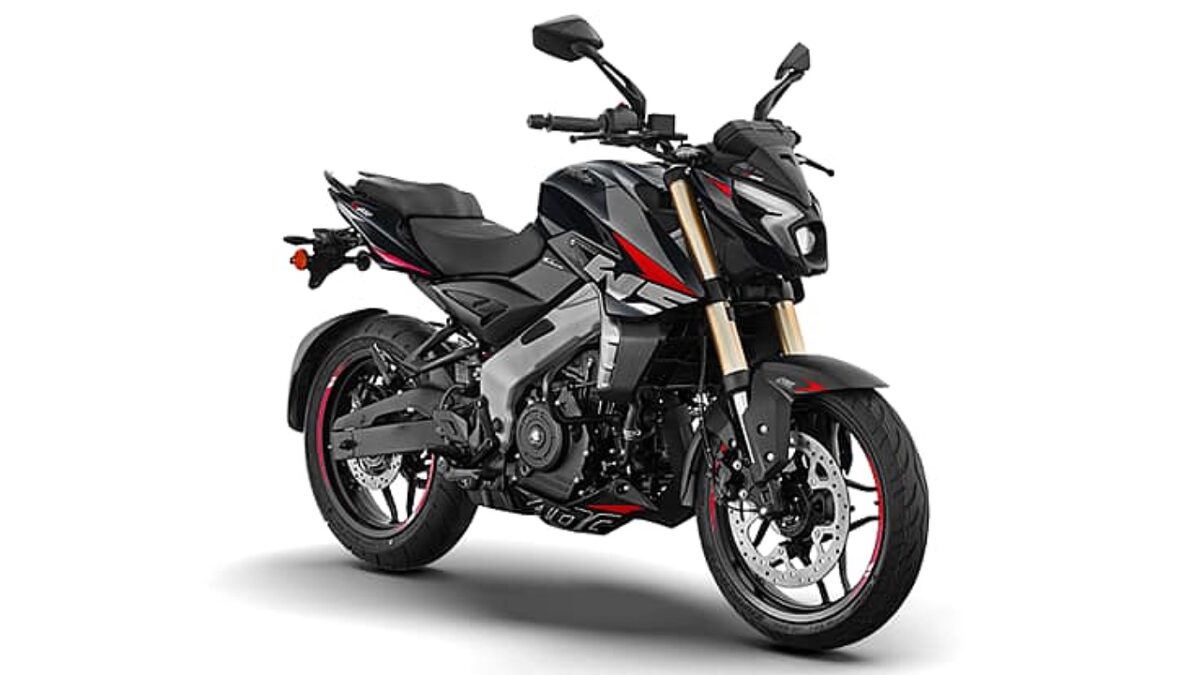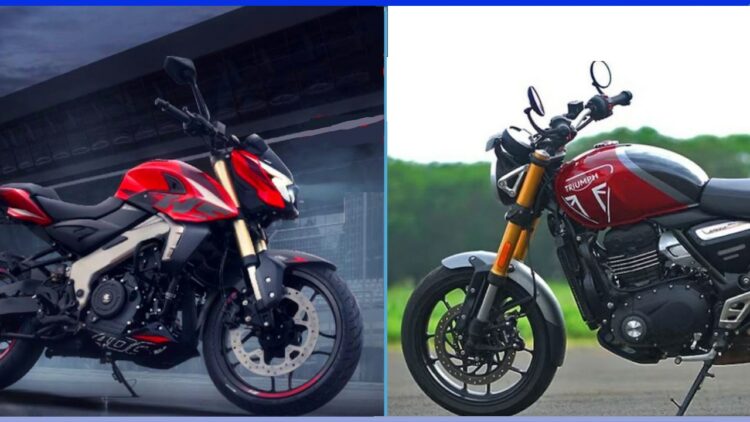In this Bajaj Pulsar NS400Z vs Triumph Speed 400 comparison, we shall take a deep look into the details of both compelling motorcycles. Note that it is the first time in the history of Bajaj that a 400-cc bike is wearing a Pulsar tag. Until now, the Chennai-based two-wheeler giant offered the Dominar 400 only. While it experienced moderate success, the Pulsar moniker is bound to bring in more potential customers. With this, Bajaj has completed an entire range of Pulsar bikes in our market starting from Pulsar 125 to the latest Pulsar NS400Z. On the other hand, people looking for a slightly more premium bike generally opt for the Triumph Speed 400. Interestingly, Triumph bike use the same manufacturing plant as Bajaj under their joint venture. Hence, it is quite exciting to see which one makes more sense for you.
Bajaj Pulsar NS400Z vs Triumph Speed 400 Comparison – Specs and Mileage
Bajaj Pulsar NS400Z
Since the Pulsar NS400Z is the latest motorcycle in this segment, let us commence this section with it. There is a familiar 373-cc liquid-cooled single-cylinder DOHC engine which produces a decent 40 PS @8,000 RPM and 35 Nm @6,500 RPM of peak power and torque. A 6-speed manual transmission with assist and slipper clutch performs the transmission duties. It is aided by a ride-by-wire electronic throttle. Apart from that, the Pulsar NS400Z gets four ride modes (Road, Rain, Sport and Off-Road). The suspension duties are carried out by 43 mm Champagne Gold USD forks at the front and a monoshock absorber with Nitrox 6-step adjustable at the rear.
To enhance the safety aspects of the motorbike, the Pulsar NS400Z gets Switchable Electronic Traction Control (ETC) and dual-channel ABS with Combined ABS technology. There are 5-step adjustable levers. At the front, the new Pulsar gets 320 mm disc brakes, while at the rear, it gets 230 mm disc brakes. The front possesses a 17-inch alloy wheel with a 110/70-section front tyre and the rear section also gets a 17-inch alloy wheel with a 140/70-section tyre. With the new Pulsar NS400Z, the buyers get a wheelbase of 1,344 mm and a ground clearance of 168 mm. It has a fuel tank capacity of 12 litres, a kerb weight of 174 kg and a seat height of 807 mm. The hydroformed tubular Streetfighter handlebar reduces vibrations and increases stiffness.
Triumph Speed 400
On the other hand, the Triumph Speed 400 comes with a bigger 398-cc liquid-cooled 4V DOHC fuel-injected single-cylinder engine which generates a healthy 40 PS @8,000 RPM and 37.5 Nm @6,500 RPM of peak power and torque. This engine pairs with a 6-speed gearbox with a wet multi-plate clutch with slip & assist. There is a ride-by-wire throttle with switchable traction control. Underpinning the Triumph Speed 400 is a hybrid spine/perimeter, tubular steel with a bolt-on rear subframe and an aluminium alloy swingarm. Just like the Pulsar NS400Z, the Triumph Speed also gets 17-inch alloy wheels at the front, as well as at the rear.
Furthermore, there are 43 mm USD big piston forks at the front with 140 mm wheel travel and gas monoshock RSU with an external reservoir and pre-load adjustment a the rear with 130 mm travel. At the front, it gets a 300 mm disc brake, while at the rear, there is a 230 mm disc brake with a 4-piston radial calliper and Bosch dual-channel ABS. Finally, it has an overall mileage of around 30 kmpl. All in all, the Triumph Speed 400 has a slight advantage over the Pulsar NS400Z in terms of torque but the power output is identical.
| Specs Comparison | Bajaj Pulsar NS400Z | Triumph Speed 400 |
| Engine | 373-cc | 398-cc |
| Power | 40 PS @8,000 RPM | 40 PS @8,000 RPM |
| Torque | 35 Nm @6,500 RPM | 37.5 Nm @6,500 RPM |
| Transmission | 6-speed | 6-speed |
| Front Suspension | 43 mm Champagne Gold USD | 43 mm USD Big Piston Forks |
| Rear Suspension | Monoshock with Nitrox 6-step adjustable | Gas Monoshock RSU with an External Reservoir and Pre-load Adjustment |
| Wheelbase (mm) | 1,344 | 1,377 |
| Seat Height (mm) | 807 | 790 |
| Weight (kg) | 174 | 176 |
| Front Tyre | 17-inch 110/70-section | 17-inch 110/70-section |
| Rear Tyre | 17-inch 140/70-section | 17-inch 150/60 section |
| Fuel Tank (l) | 12 | 13 |
| Front Disc (mm) | 320 | 300 |
| Rear Disc (mm) | 230 | 230 |
Bajaj Pulsar NS400Z vs Triumph Speed 400 Price Check
In terms of the pricing, Bajaj has taken everyone by surprise after a mighty attractive retail price of Rs 1.85 lakh, ex-showroom. While this might be an introductory price, it has to be among the most affordable bikes in this segment. In comparison, the Triumph Speed 400 sells for Rs 2.34 lakh, ex-showroom. Hence, there is a significant difference of a whopping Rs 49,000 between the two. Hence, the new Pulsar has a distinct benefit in this regard.
| Prices | Bajaj Pulsar NS400Z | Triumph Speed 400 |
| Ex-Showroom | Rs 1.85 lakh | Rs 2.34 lakh |
Features Comparison
Both these are big bikes which means that the features list on the two will also be massive. Being the flagship model from Bajaj, the Pulsar NS400Z offers the latest bells and whistles to pamper the owners. To begin with, let us delve deep into what the new Pulsar NS400Z offers.
- Colour LCD Speedometer
- Turn-by-Turn Navigation
- Bluetooth Connectivity
- Lap Timer
- Carbon Fibre Graphics
- Music Control
- Traction Control
- Missed Call and Message (SMS) Notification
- Mobile Battery Charge Status
- Call Accept and Reject
- Brightness Control
- USB Socket Charger
- Mobile Network Strength Status
- Hazard Lamp Switch
Similarly, the top amenities on the Triumph Speed 400 include:
- Analogue Speedometer
- Integrated Full-feature LCD Display
- Anti-Theft Immobiliser
- USB-C Charging Socket
- Handlebar-mounted Scroll Button to Operate Instrument Display
- Smartphone Connectivity
- Navigation
- LED Headlamps and Turn Indicators
- Heater Grips
- Gear Position Indicator
- Over 25 Genuine Accessories
Design Comparison
Both these bikes carry distinct exterior appearances. On one hand, the Bajaj Pulsar NS400Z is inspired by the NS200. Hence, it looks sporty with an aggressive front end, body graphics on the sides, a sculpted fuel tank, a sporty demeanour, stylish alloy wheels, a split-seat setup, a sleek tail section, rugged side body panels, compact exhaust and more. On the other hand, the Triumph Speed 400 bears a slightly retro look with a round headlamp, oval fuel tank, inverted rear view mirrors, traditional long exhaust pipe, etc. In fact, it oozes cruiser bike vibes. Hence, both these motorcycles will have their definitive customers.

Our View
The 400-cc segment in our market is heating up. People with discretionary income are moving toward buying bigger motorcycles. They want to enjoy the pleasures associated with riding big bikes on highways. Interestingly, the Pulsar NS400Z differs from the Dominar 400 in the sense that the former is much more practical even in the city. It is not as bulky as the Dominar. Hence, the users can take it around to manoeuvre around in a city, as well as on highways where its performance is needed to cover ground quickly, as well as overtake.
On the other hand, Triumph represents the premium motorcycle brand. It offers a distinct appearance and road presence. One can’t just mistake it for anything else. Apart from that, the engine is also slightly more peppy in comparison to the Pulsar NS400Z. Hence, the owners would enjoy it on long highway trips and cruising situations. In essence, I would encourage you to go and experience both these motorcycles in the flesh and take a test ride. That will acquaint you with the idiosyncrasies of both these motorcycles. That will allow you to take a more informed decision as per your own requirements and desires. In any case, you can’t go wrong with either of these.
You may also like: Bajaj Pulsar NS400Z vs KTM Duke 390 – What to Buy?


